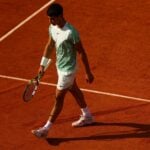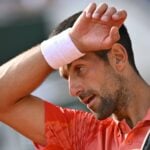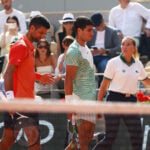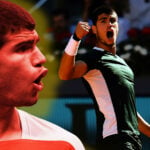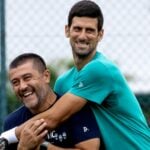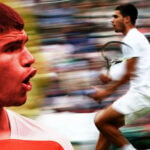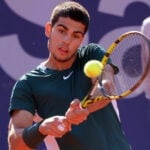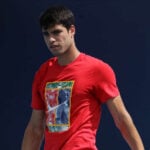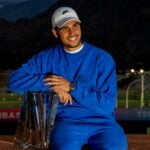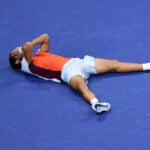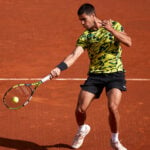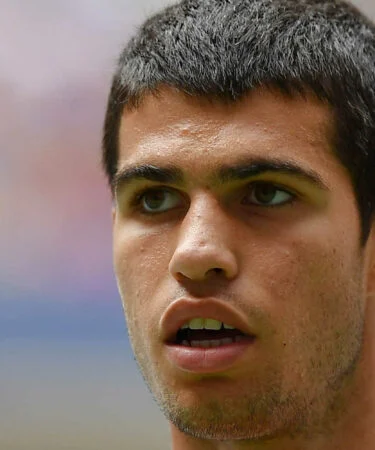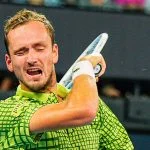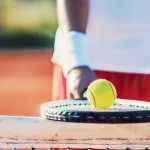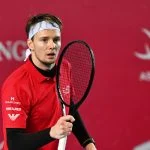To worry or not to worry about Carlos Alcaraz’s body?
Should we start wondering about the string of injuries sustained by the tennis world’s new superstar?
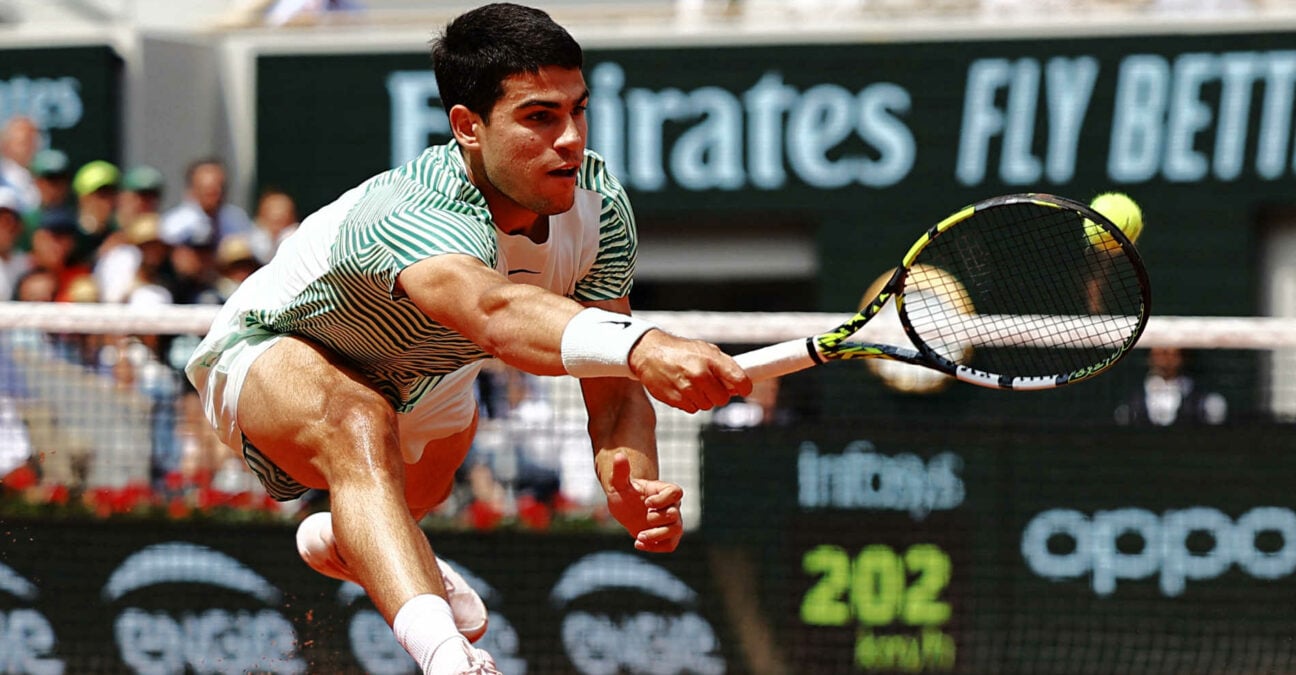 Carlos Alcaraz, Roland-Garros 2023 | © AI / Reuters / Panoramic
Carlos Alcaraz, Roland-Garros 2023 | © AI / Reuters / Panoramic
Not trying to be a Debbie Downer here about Carlos Alcaraz, nor a drama queen. We’re not doing a reboot of the Andre Agassi “He’s writing cheques that his body can’t cash” about Rafael Nadal in 2005 either.
We’re just wondering, especially after what happened against Novak Djokovic in that semi-final in Paris. And of course we all know how the physical demands on players have dramatically grown since 2005 in a Tour where the word ‘rest’ has basically disappeared from the dictionary.
So the thing with Alcaraz is that we’re starting to have a list of injuries of physical disorders long as his amazing performances. And he is just 20. Let’s start by reviewing the facts with a list of what went wrong with him lately.

In November last year, he finished his season in Paris due to an abdominal tear and so missed the ATP and the Davis Cup Finals. In January, he was still not able to get back to the Tour as he had to miss the Australian Open following a right leg injury. As simple as that: his body didn’t let him chase glory on the two first major events of the year.
Alcaraz came back in February, won the tournament in Buenos Aires, and reached the final in Rio where he sustained a tear in the right leg, so he pulled out of Acapulco.
“I disappointed myself, honestly”: Alcaraz at Roland-Garros
Alcaraz then came back right in time to win the Masters 1000 in Indian Wells and reached the semi-finals in the Masters 1000 of Miami. But he then had to give up on the third Masters 1000 in Monte-Carlo following injuries to his left hand (post-traumatic arthritis) and muscular discomfort in the spine.
In Roland-Garros, he played like perfection until reaching the semi-finals and then broke down after two and a half hours against Novak Djokovic, finishing the match despite being barely able to move.
This one was as much physical as mental as Alcaraz admitted that facing Djokovic was leading to so much tension that it made him cramp. “I disappointed myself honestly and in a match like this, coming to this match with great feeling, feeling great physically, and cramping at the end of the second set, beginning of the third set, it was really disappointing. I started to cramp every part of my body, not only the legs. The arms, as well, every part of the legs. I started match really nervous. It’s not easy to play against Novak, a legend of our sport.”
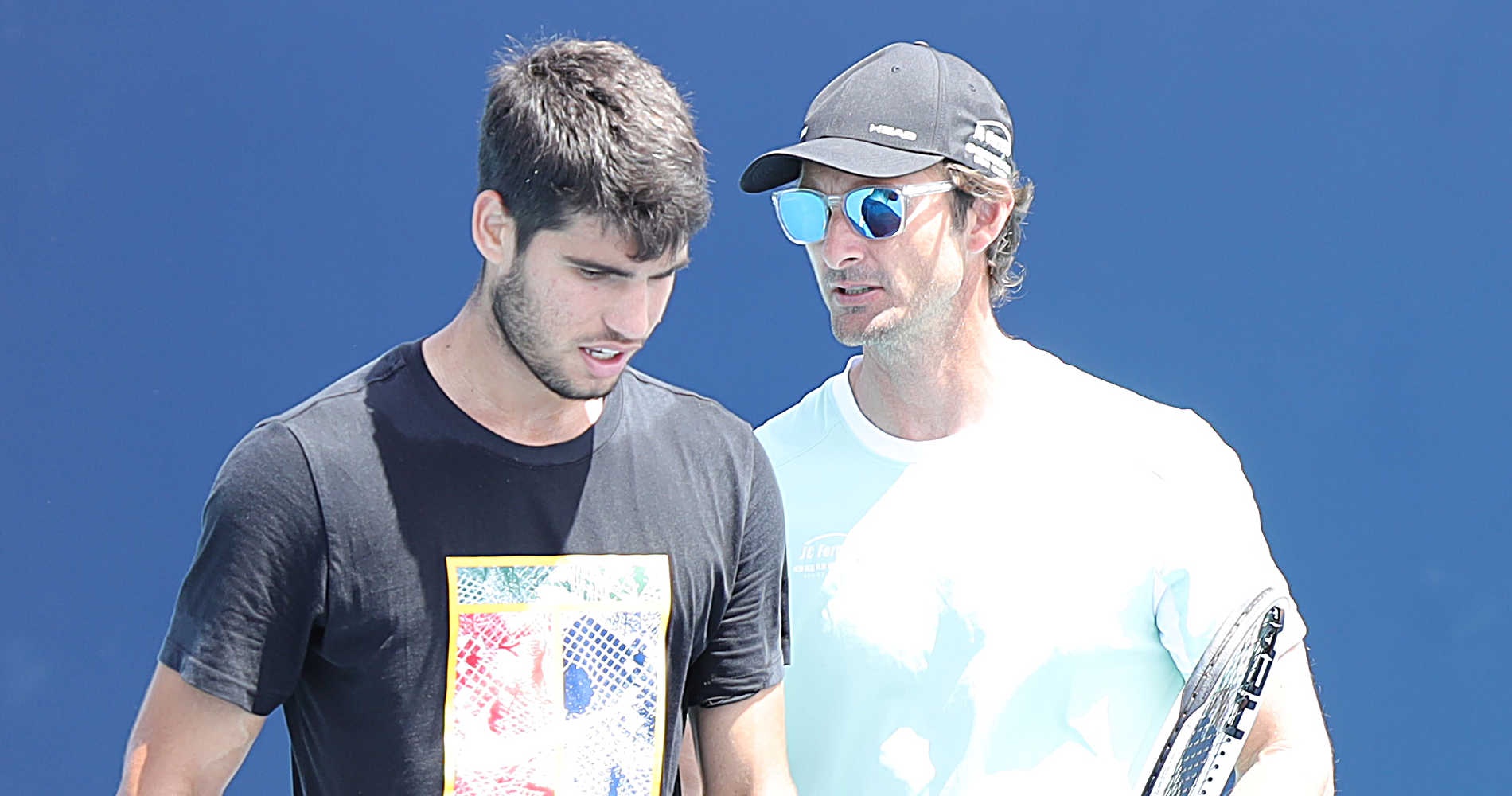
This year, it’s either he wins or he breaks. Sure it’s amazing to see him bounce back from those injuries that quickly each time, but should we still avoid worrying about the pattern or is there really a cause for concern? His coach Juan Carlos Ferrero has all his former top player experience to use in this department too, and for now, he is not worried about what’s been happening to Alcaraz.
“Injuries in tennis are normal,” he recently told Tennis Majors. “We made some changes these latest times, on small details of his journey. We monitor everything, tuned up here and there. Everything is really good now. And don’t forget that everything was so stressful after he won the US Open. All the people came to see him to say: ‘You’re so good, blah blah blah’… It’s difficult to practise like before and to do more things for the sponsors and everything. Now he’s on the way again.”
A bumpy way, but still a way. And for sure when you only watch the titles he’s been able to clinch in his fantastic rise – since September last year : a Slam, two Masters 1000, four titles –, all is well in Alcaraz’s world. Yet I also remember time and time again when I’ve been told by coaches that it’s when things are going well that sometimes you should work even more on making sure they stay this way.
When you lose, you’re forced to question what you’re doing because apparently it’s not fully working; but when you win there’s a tendency to put the little warning signals under the rug. So winning is actually the perfect time to go and look under this rug with zero pressure or stress. Just to have a look at what’s building under it all.
Nacho Encabo, an experienced tennis journalist now writing for Relevo, a new Spanish media, has also been wondering about what could be under that rug. “I think that what has happened in recent months should be a cause for concern. Alcaraz is a tennis player who has practically never had injuries and in just a few months he has suffered three (now four). Alcaraz himself acknowledged that the first injury (against Rune in Paris) could be the result of certain bad habits after reaching No 1, but the injuries in January and February can no longer be attributed to that.”
Alcaraz has indeed been very transparent about not only the injuries he’s been sustaining but also why he might have been at fault for some of them. In terms of maturity, it’s like with his level of play: Alcaraz goes well beyond his years.

It is important to do the right things off the court as well as on it, and I wasn’t always doing that 100%
Carlos Alcaraz
So yes, after missing Melbourne because of an injury, he looked his ego in the eyes and wondered what he could have done better. “When you miss a huge tournament like the Australian Open, you think about what you are doing wrong. An injury can happen to anyone, but when I analyzed the situation with my team, we concluded that it is important to do the right things off the court as well as on it, and I wasn’t always doing that 100%. I’m talking about rest, nutritional supplementation, eating well, etc. There were a number of things that maybe I wasn’t doing right. Through the injury, I learned that I had to get back to the routine I had previously, to get back to doing all those things right to be at my best. I think because of the injury, I’ve been doing that now and it’s no secret that, when you do things right, good results will follow.”
And they did follow as Alcaraz won in Buenos Aires, so sure that he had found out the origin of his injuries streak. “It’s really special. I struggled for four months,” he said in his on-court interview. “I didn’t do the right things off the court and I felt a little bit guilty after the injury and struggled with that; it was not easy. To come here to my first tournament after four months, and to win my first title since the US Open is a really special moment for me.”
But the injuries came back and as Alcaraz corrected all he could from his off-court habits, the logical answer now is that those new injuries have other causes. And maybe, in the end, the previous ones too.
“Playing with some pain is normal for a tennis player”, Alcaraz
But still, Alcaraz refuses to worry about it. He’s not young and reckless: he’s young and confident about his work ethic. “I don’t worry about that. It’s a tennis player’s life. Playing with some pain is normal for a tennis player. Even more, if we are playing win after win, with no break for almost 14 days in a row. It’s normal. I’m going to take care of that and go into the final 100 percent.”
That’s what he said after reaching the final in Rio, right before his right leg injury got worse. Coming back to Indian Wells, Alcaraz was still in the same mindset: nothing was going on except bad luck. Before the tournament, when some were inquiring about his busy schedule since coming back from injury after Melbourne, he didn’t budge.
“I’m not worried about it all. I would say it’s bad luck. I’m doing the right things off the court and it’s really important to the injury. I think I’m doing great work. I just have bad luck sometimes. Playing a lot of days in a row, as I did like 15 days in a row, with no days off is really tough. Of course, I’m gonna take that lesson probably during the year and have some days off during the tournament and not get injured, but I’m not going to worry about it. You have to be patient. I’m a lucky player that I have a really good team behind me. I have a really good physio as well so we know how to recover from an injury well.”
In Miami, after his win over Facundo Bagnis in his first match, he again insisted on how he had put himself back on the right track. “I had to take care of myself a little bit more off the court, taking care about going early to bed, resting better, eating well, taking care of myself off the court. That’s the most important thing for me. I would say I didn’t do as well as I wanted to. But after the injury in January, I started to do better on the off-court things.”
“It doesn’t necessarily mean that Alcaraz is going to have many injuries during his career”: Blanca Bernal, physiotherapist
Blanca Bernal is a Spanish sports physiotherapist working in the tennis industry since 2009. She has worked for ITF, WTA, and multiple players as a private physio, and now is the physiotherapist for the Spanish Billie Jean King Cup team and for Sara Sorribes Tormo. In her experience and expertise, what would be the signs to look at when wondering if a string of injuries is caused by bad luck or by a deeper issue?
“It really depends on whether the injuries are always of the same type (e.g.: muscle injuries on different muscles), which would ring a bell; or if it’s different injuries happening each time, which can be just bad luck, as in competitive sports there are many things that are just out of your control as a physio. I always pay a lot of attention to everything that is going on off the court as well: nutrition, hydration, rest, and emotional situation… And when needed, double-check with blood tests and other tests that can help find the answers.”

As for the recent issues Alcaraz encountered, she believes we’re more looking at a young player catching up very quickly to the demands of the highest standards of the game. In the long run, he should be fine.
“There are moments during a player’s career when injuries happen more often, and this has to do with many different things, but it doesn’t necessarily mean that Alcaraz is going to have many injuries during his career. The load, the physical changes a player goes through, the emotional aspects… it all has an influence. Alcaraz has had to cope with massive changes in his life and his career in six months, and that’s not easy for such a young athlete.
“From my point of view, although he had a long injury right before the Australian Open this year, there are other situations in which his medical team probably protects him, stopping him on time before minor injuries end up being more severe ones, and that is something wise and smart. As part of a player’s medical team, you always have to think in the long term.”
In April last year, Juanjo Moreno, Alcaraz’s physiotherapist, was adamant that the work frame set around him was perfectly adjusted to his needs. “Although this effort may be new to his body, it’s not for his team,” he told the ATP Tour.com. “We know how the body responds to these types of exertions. We have both the experience of Juan Carlos Ferrero and the science from the medical and technical team.”
“(…) The aim has always been to be safe rather than sorry. In the team, we have established very good physical work for him, from which he also acquires some healthy sporting habits, in which recovery and restorative sleep play an important role. Fitness work, nutrition, rest, recovery… All of that requires hard work as part of a lifestyle we have tried to instill in him. These are the values the team believes in and it’s our way of working every day.”
“When he was a kid, it was hard for him to have a training routine”: journalist Nacho Encabo
For Moreno, this is what makes a hard-work culture as he explained at the time. “If I had to single out two of Carlos’ strengths, it would be talent and the culture of hard work the team has taught him,” he said. “We have managed to instill in him the fact that, without hard work, the talent will not reach its potential and that at this level it is necessary to take care of every detail.”
As Spanish tennis writer Nacho Encabo explains, it has not always been in Alcaraz’s DNA: “When he was a kid, it was hard for him to have a training routine, but he has perfectly understood everything he has to do and sacrifice to be the best tennis player in the world.”
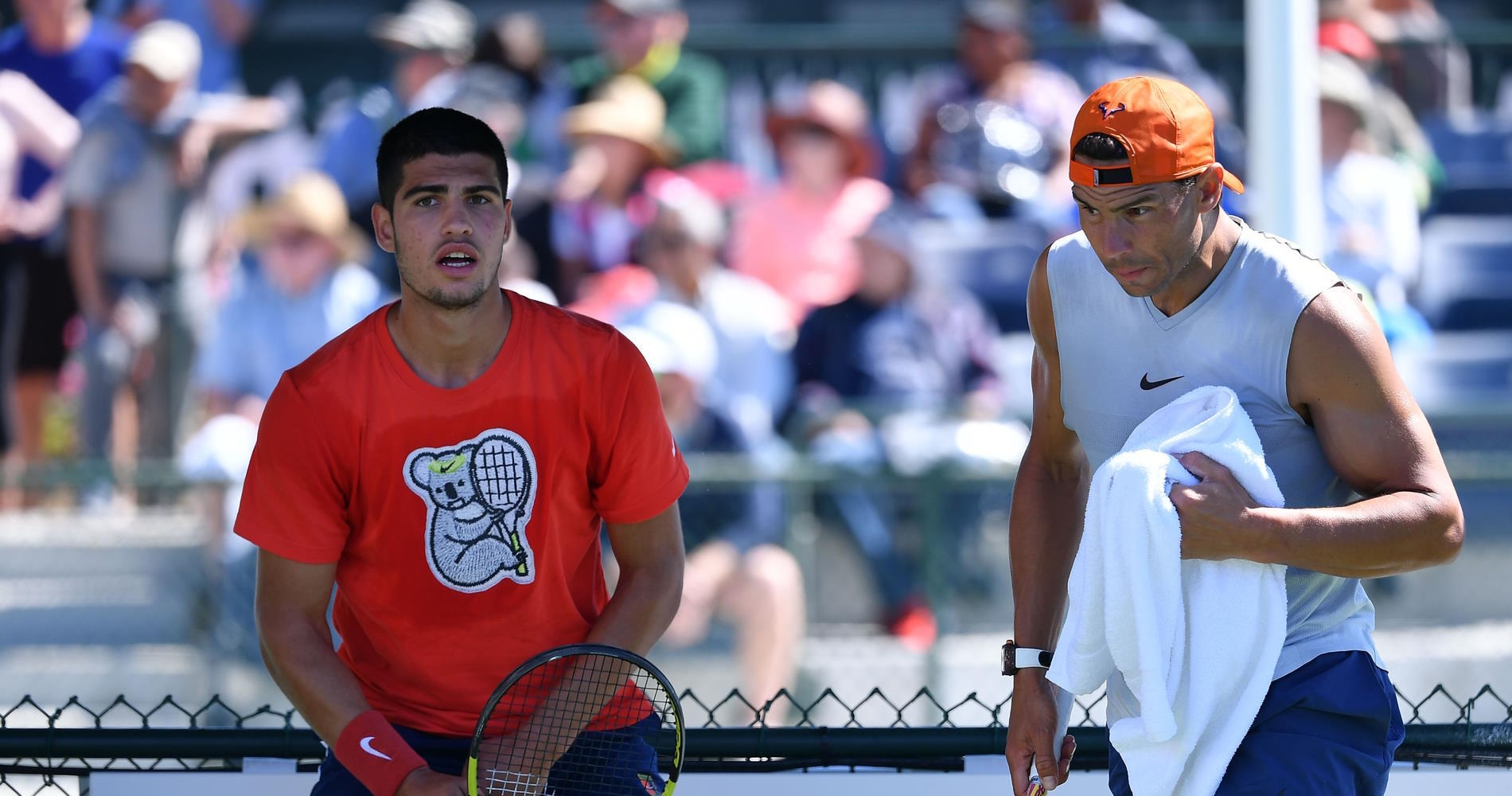
Should there also be something to say about the Spanish sports culture? Should this be another of the parallels used between Nadal and Alcaraz? One can wonder. Are injuries even more seen as an unavoidable evil in Spain than in other parts of the sports world?
Is the “play until you break if it’s needed” more prevalent there? “I believe that it is not a cultural matter of Spain, but a characteristic of the big competitors,” says Encabo. “In modern elite sports, you have to know how to overcome injuries, how to play with them, and how to recover. Tennis has become an increasingly demanding sport from a physical point of view and I think that what Alcaraz has to learn from Nadal is not so much how to recover from an injury, but how to prevent it: lighten the calendar and focus on the big tournaments. But at the same time, I understand that at 19 years old [now 20 – editor], you want to play everything and you want to conquer the world.”
Tennis has become an increasingly demanding sport from a physical point of view and I think that what Alcaraz has to learn from Nadal is not so much how to recover from an injury, but how to prevent it
Nacho Encabo
In tennis, it might also be more a question of game style than philosophy in Blanca Bernal’s opinion. “Are we, Spanish, ‘sufferers’? Maybe, because of the classic Spanish tennis style, our players need to be physically tougher, so why not? I personally do not think Rafa’s situation with injuries has been from pushing too far too many times. He has been well guided throughout his career by a superb medical staff.
“I see it as a mix of his physical qualities and condition, tennis demands and biomechanics, and luck. Rafa has a couple of chronic conditions that have been well managed over the years, but of course, at some point, they are going to flare up. That’s normal during almost 20 years of tennis career. The rest he’s had are acute injuries every other player could have. And if it is as you say, a product of pushing, then it has to do with his mentality, and that mentality has also made him the best of all times, so I guess he happily pays the price.”
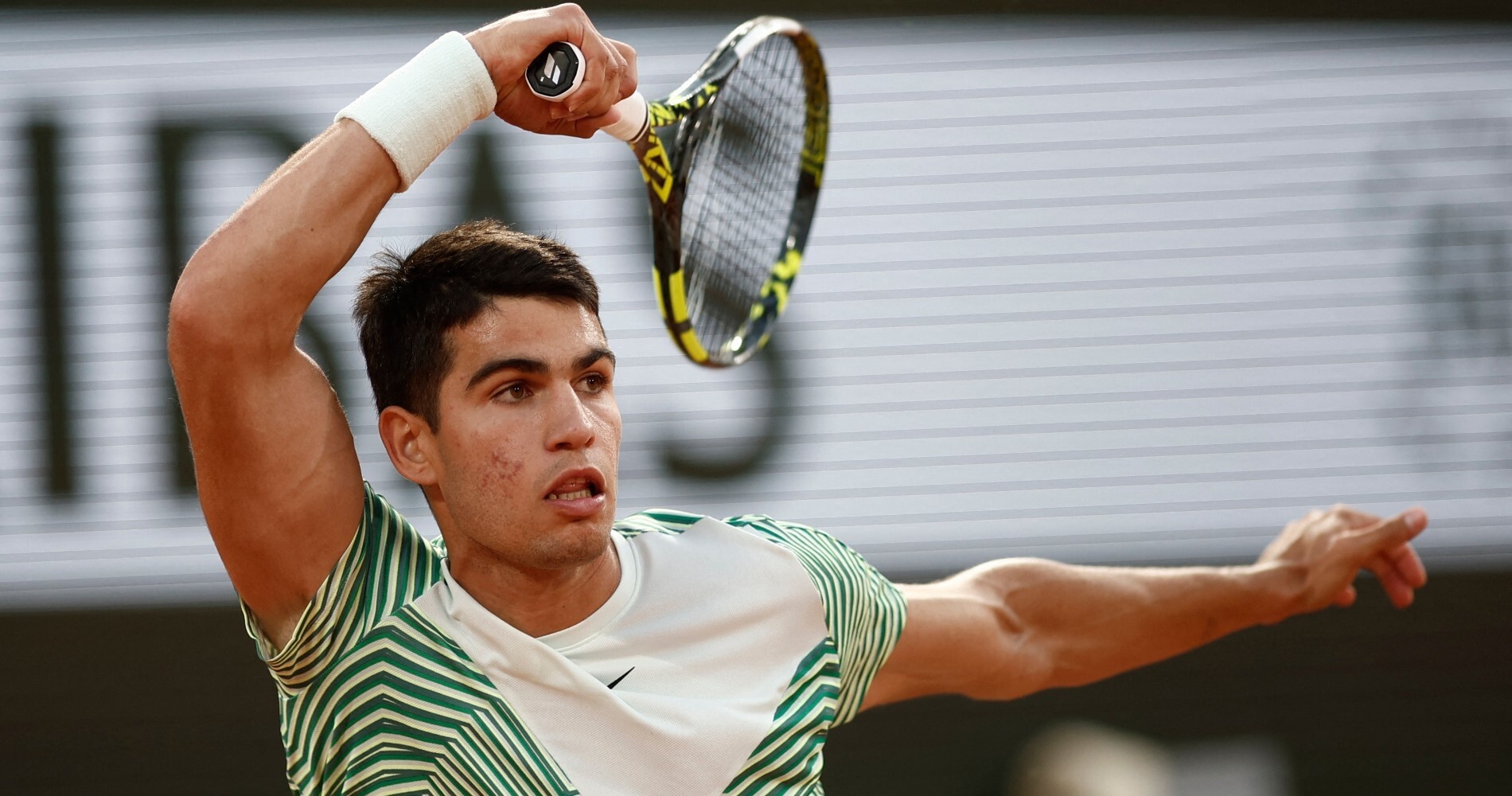
The injury mythology created by the Big Four
The Big Four’s legacy will have so many consequences in that sport in the decades to come. I just worry that one of them will be the ingrained belief that one can come back from any type of injury and be back in one’s best shape, ready to take over the world again and again. It seems to me a very risky approach for the next young tennis stars to base their path on a generation of exceptions.
Yes, the four of them consistently came back from injuries to win big titles again. Yes, two of them were very rarely injured before reaching their 30s. But one of the Avengers – Murray – destroyed a hip in the process. And another – Rafa, currently on crutches – had such a long list of severe injuries that it took all of his out-of-this-world mental strength to get through them all.
It’s not normal to come back from a severe knee injury (Federer) or a severe elbow injury (Djokovic) and win Grand Slam titles and/or become world No 1 again. It’s not normal to win 14 Roland-Garros titles (and the last one on only one working foot) despite damaging basically every limb you could have broken through a career (Nadal). So either Alcaraz will be proven to be made in the same alien metal as these four guys, or he shouldn’t put a single foot on that path at all. It’s a bold thing to do to bet that you have a Big Four tennis DNA, but Alcaraz seems to be making it right now. And he indeed came back amazingly strong from those recent injuries.
“I thought a lot about Nadal when I was recovering from my injury,” Alcaraz wrote for Eurosport. “Often when the best players have been out for a long time, they win their first tournament back. I wanted to be one of those players. Those examples of successful returns have motivated me – like what Rafa did at the 2022 Australian Open, and when Djokovic returned from absences, he won important tournaments.
These examples are inspirations to think, ‘let’s get back training’ because I also want to come back the best I can to try to win…’”. He said the same in Indian Wells, still firmly fixed on following in those illustrious footsteps. “I look at the big players, [Novak] Djokovic or Rafa [Nadal], when they are coming from an injury, and probably they have a great percentage to win the tournament after an injury.”
“One may think Rafa and Djokovic make it look easy, but…”: Bernal
There’s a Roger Federer quote that is immediately jumping into my mind when hearing this: “I’ve created a monster.” We were in 2008 and he had just lost his Australian Open semi-final against a young Novak Djokovic, breaking a run of 10 consecutive Grand Slam finals. “Of course, I’ve created a monster, so I know I need to always win every tournament. But semi-final is still pretty good.”
This whole Big Four generation has created multiple monsters. Taking them as inspirations is amazing, but taking them as a step-by-step manual is a dangerous game. You more often follow a rule than an exception. Unless again you’re 100% certain that you’re also the exception. But we have a list of players who were called the next Big Four already… And, breaking news: they didn’t happen to be them.
“One may think Rafa and Djokovic make it look easy, but I agree that coming back from an injury is always a tricky situation,” says Blanca Bernal. “I think most athletes respect injuries and take enough time to recover, but tennis is a very particular sport, and the ranking system can put players through difficult situations if they are out for too long, especially when you are ranked close to the 100. But it is great to have good examples of coming back stronger, and I believe there is always something positive in every recovery process. Time off competition allows tennis players to see things from a different perspective and that somehow changes their mindset when they come back.”
Will Alcaraz have to change his game style at some point?
Carlos Alcaraz is for sure the first one really looking like the Big Four’s heir, no doubt about that. Yet seeing his 19-year-old body already getting damaged week in and week out is ringing a little alarm in my mind. Something like “It’s way too soon and way too often”.
And there are actually a couple of big things to take into account for Alcaraz right now: he has a very demanding game style, and tennis has changed in the way that the depth is huge in the ranks and that the moments to rest have become so rare that you’re not sure they’re real.
“The change in speed is incredible,” confirms Blanca Bernal. “That has changed completely the way the players position their feet to hit the ball, using now more than ever the open stand, with the consequences that has on the hips. For me, that’s the biggest change in the past 10 years. I think it all starts from the base. I see huge differences in injuries in adolescent players which have to do with their technique, for example. Having good warm-up and prevention routines is also key to then have healthier professional players. In terms of load and competitive stress, what the WTA did by limiting the amount of professional events players could play before they were certain age I think is smart, but it makes no sense if they end up playing juniors all year long.”
Of the numerous comparisons already happening between Alcaraz and Nadal, not all are accurate. One is, though: the energy on each ball played. Young Nadal didn’t know or care about what not playing each point at 200% meant, and sure enough, Alcaraz doesn’t know either. Stepping on those brakes? No, thanks. That’s why he’s that spectacular on the court and why despite his young age he’s been rising that high that quick: he goes for the jugular on each shot, he’s going to chase all the balls, he’s going to hit every forehand harder until it breaks you, he’s going to play each ball as if it was the last.
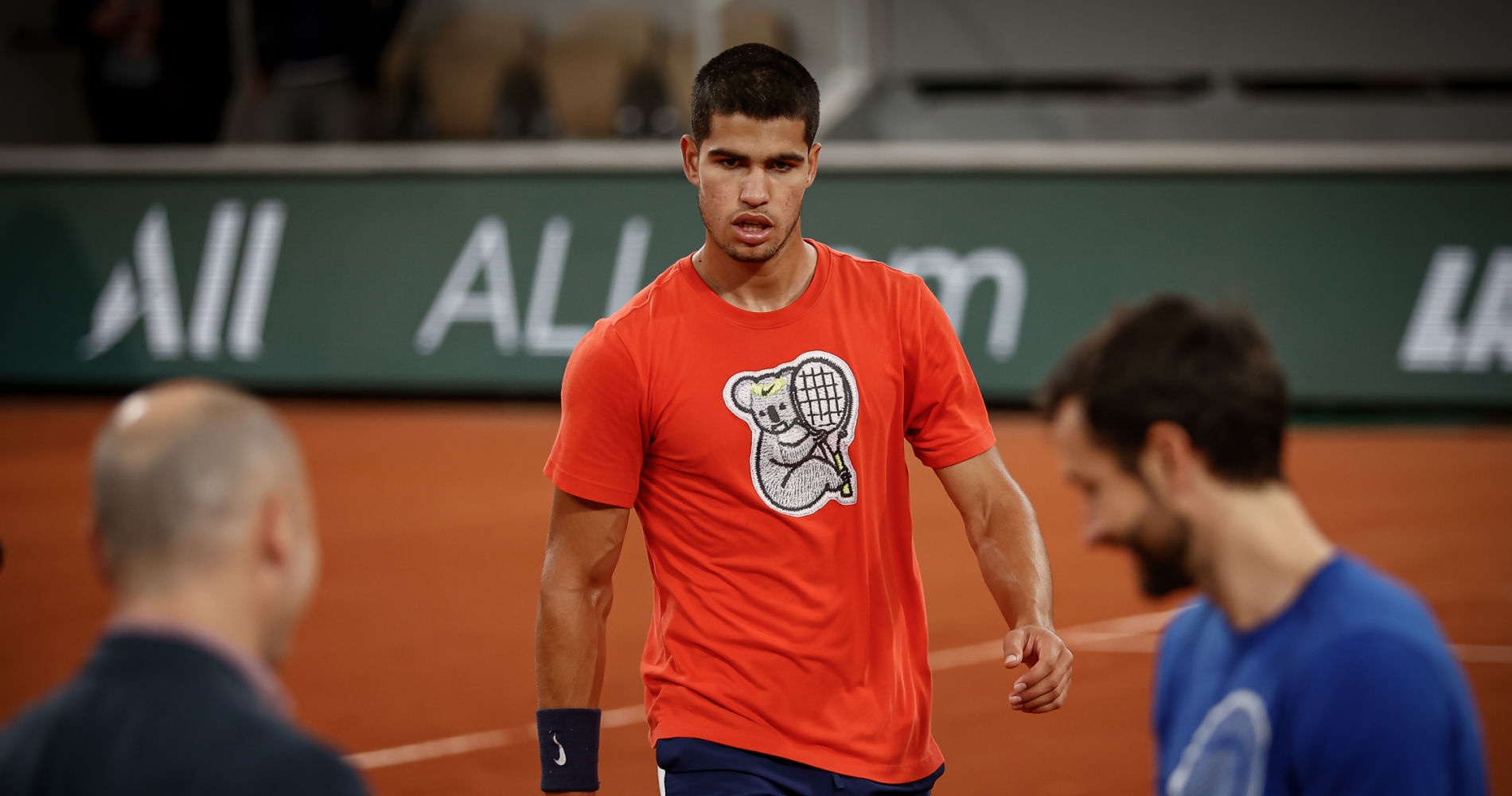
And it’s the same at practice because he understands that you play as you practise, and because he has all the energy of youth to spare. With that game style and that fast rise to the top of a game where the level of fitness keeps rising, injuries were maybe the logical consequence.
“Not necessarily so many injuries in such a short period of time. That’s bad luck,” thinks Bernal. “But yes, at some point he is going to get injured. He has physically changed a lot, and I think his body is still learning to adapt to those changes and the competitive load he has to cope with. He also plays and moves in a way where the demands on his muscles, tendons, and joints are very high. That’s why he’s so good, but that also pays a price.”
Does she see a lot of players coming to her with injuries they should have never kept playing on? “Unfortunately yes, this happens too often, as it is difficult for the player to know when they are crossing the red line. Better education is key: Being able to identify not only the localisation of pain, but also the type of pain, and being able to quantify that pain in a way that means the same for the player and therapist.”
The weight of those muscles
Alcaraz has indeed changed a lot physically as everyone has seen these muscles grow and grow. So it would be logical to think that his 20-year-old body is currently rushing to catch up with those changes all the while also rushing to keep up with the demands of fighting for the biggest titles in a sport where the body has to be strong, fast and explosive but also able to last for hours and hours. It’s a lot.
“Injuries are a consequence of many factors,” says Bernal. “It has to do with training, competition load, how athletes rest, how they eat, and how they manage their emotions… Sometimes the body has resources to cope with all this, and sometimes an extra demand can trigger the injury. Tennis is a very complicated sport in many ways, not only the physical conditioning is challenging. But yes, it is not easy to train a powerful and enduring body.”
What plays in Alcaraz’s favour here overall is his ability to already cope well mentally with those injuries. “The injury has been a learning process,” Alcaraz explained in his essay on Eurosport. “I had to be calm and it has helped me to mature a lot off the court. These were not easy days for me, they were quite hard. I had to stay focused and train to come back stronger. During my recovery, as I have done on several occasions, I worked a lot with my psychologist. She helps me a lot both on and off the court. The off-court side is almost more important, as you spend most of your time there.” He clearly has his head firmly set on those shoulders and hasn’t given the impression of a player dealing with every injury as if they were a curse from the universe. Frustration for now is under control. Also surely because he has a big team that keeps reassuring him and keeps building plans to cover all bases.
“Alcaraz’s body has to get used to the demands of a circuit that runs from January to November”, Encabo
“Alcaraz is still surrounded by his usual team, his most trusted men (Juanjo Moreno, his pysio, and Juanjo López, his doctor),” explains Nacho Encabo. “I think they are clear that Carlos has to continue evolving from a physical point of view. Right now they are not worried about injuries because they understand that it is a consequence of the jump to the elite, that Alcaraz’s body has to get used to the demands of a circuit that runs from January to November.”
They’re not worried but they’ve started planning, maybe a bit earlier than scheduled, the necessary game evolution that their player might have to go through to still be thriving on that Tour in five or ten years. Antonio Martinez Cascales, part of the coaching team, told Encabo in Barcelona this week that injuries were the risks to pay for Alcaraz’s game but that this game surely will have to age well to stay on top.
“That streak of injuries does not worry me. I have always thought that his way of playing, that he goes to the limit, 100%, that he goes for each ball even if it seems impossible, can lead you to have an injury more than necessary if you’re unlucky. But that way of playing is the one that has taken him to number one, the one that makes him like that, the one that makes us have so much fun watching him play. Over time he will moderate that extreme way of playing,” he says. “I hope that it moderates it, but just a little so it does not lose its essence, because it must always be a sign of its identity and what is going to make it what it is.”
Watching Alcaraz’s body pay the price every other week basically this year for the game still makes one wonder. Especially as he’s not the only young player at all to already have a long list of ailments. Even when watching the juniors, you’re seeing tapes and tapes and tapes on every possible joint. Players have much longer careers than before because training and injury prevention have improved a lot. But if that means that they’re going to start breaking in their teens and so hurting way into their 30s, is that really progress?
“Competing at a professional level at a younger age puts a lot of stress on their bodies, which are probably still developing. That is hard itself, no matter the sport,” says Bernal. “In tennis, you have to add the fact that they travel internationally every week, and they play on consecutive days if they keep winning, and sometimes they play at midnight. Think of any other sport this demanding, you won’t find it. So yes, athletes will get injured, even though we physiotherapists try really hard for that not to happen.”
So in the end, Carlos Alcaraz at 20 being already on the “regularly injured list” seems an unavoidable consequence of what his game is, how good he is, how rough the Tour is, and how bad luck doesn’t care about you being the next big thing. How long will Alcaraz’s body take to get used to this “Survival of the fittest” era? That seems to be the main question now. Assuming his body will at some point start coping. Because actually, nobody knows. As nobody knew about Rafael Nadal either.
Alcaraz did find a way through the clay season to come back roaring and so won in Barcelona and Madrid. He lost surprisingly early in Rome but didn’t show any extra sign of fatigue when in Paris. Yet his body betrayed him again, being unable to handle the pressure, and at the worst time when he was supposed to take over Novak Djokovic in order to cement his grip on the Tour.
Or at the minimum, when he was supposed to show he was ready for it. Can we still think it’s all a coincidence? Can his team? The sport as a whole surely hopes that Alcaraz is going to figure it all out as he has become such a blockbuster in a young generation that seemed ready to handle the Big 4 comparison. But only time will tell if Alcaraz’s career will turn into a sprint or a marathon.
